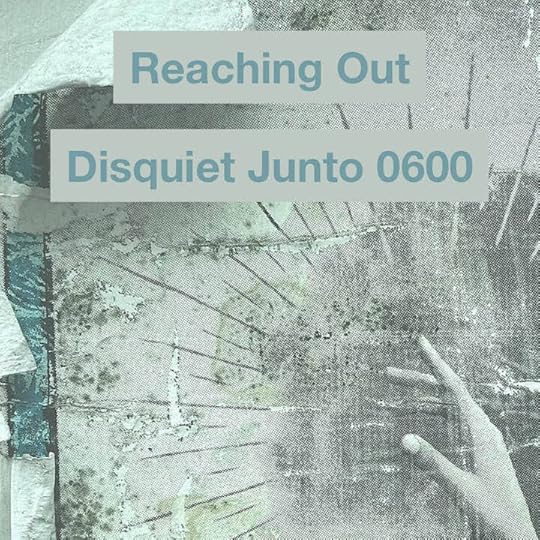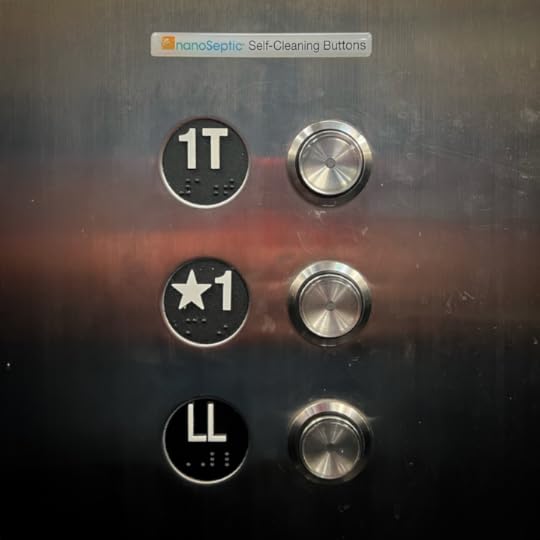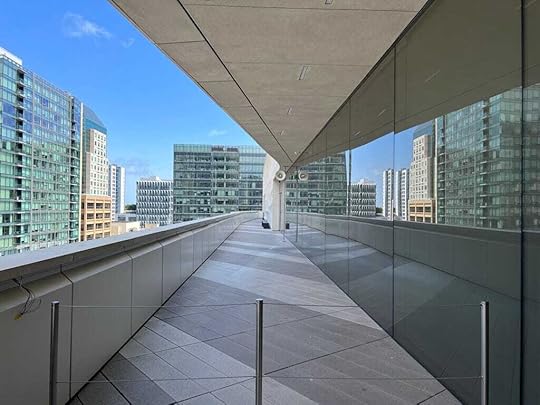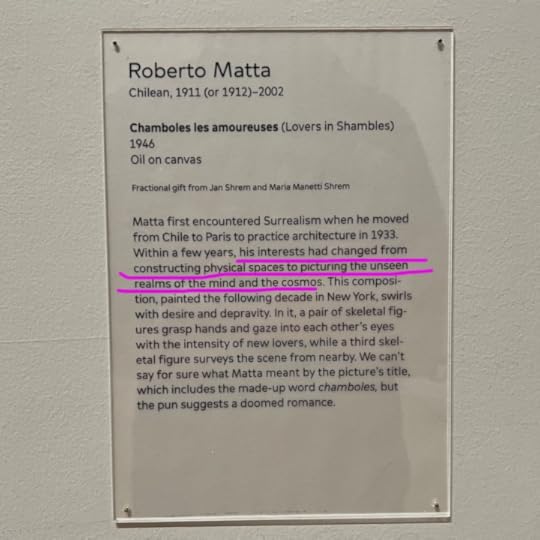Marc Weidenbaum's Blog, page 95
July 2, 2023
Audium Audience Chatter
The Audium is a longstanding space for experimental, immersive sound in San Francisco. The venue was originally housed in an old building in the Richmond District, opening in 1967 after over a decade of planning and one-off performances, and it has been closer to the City Hall area, on Bush Street, since 1975. The Audium’s small auditorium has no windows. When the concert begins, the lights are fully turned off. Aside from dimly glowing arrows on the floor that direct toward the exit, it is pitch black; you can’t see your own hands, let along the person seated next to you. I attended an evening concert there on Saturday, July 1: a revisitation of a 1969 work by cofounder Stan Shaff (the other founder was Doug McEachern), with Shaff’s son, David Shaff, performing. The piece was an hour long. It consisted of mostly real-world sounds — sirens, horns, bells, balloons, traffic — being moved around the room’s 176 individual speakers, and transformed in the process: filtered, slowed, garbled, dissected. In addition, one heard fantastical abstractions and bits of found media, what seemed at times like soundtracks to TV shows and commercials. There was a 10-minute intermission halfway through the concert. I shot this short video during the break as part of my ongoing series of 30-second field recordings (I’ve been posting these vertical videos at instagram.com/dsqt and tiktok.com/@disquiet.com). I’m always interested in chatter when the combined verbalization transcends communication and becomes a matter of texture, tonality, and rhythm. I was especially keen here to witness whether the specific circumstances in any way impacted the way people spoke, both individually and collectively — did they perhaps hear themselves, in this tiny room, as source audio for an intimate, spatial performance like the one we were all there to experience?
July 1, 2023
Scratch Pad: Bandcamp, Fireworks, X-rays
I do this manually each Saturday, usually in the morning over coffee: collating most of the little comments I’ve made on social media, which I think of as my public scratch pad, during the preceding week. These days that mostly means Mastodon (at post.lurk.org/@disquiet), and I’m also trying out a few others, including Bluesky (disquiet.bsky.social), which remains behind a beta firewall at the moment.
▰ “This person called, but left an empty message”
The digital silence of unanswered robocalls
▰ The AudioMoth field recorder had its first multi-day overnight in the backyard, and the resulting 1080 files were, thankfully, automatically divided into three different folders, one for each day.

▰ I was doing some research that led me back to some ancient issues of Scientific American, and came across some excellent home-audio fear-mongering in an advertisement about turntable care.

Person: “Oh, you like sound. You must love the Fourth of July, all those fireworks.”
▰ Time for the annual conversation:
Me: ” … “
▰ Mundane crowdsourcing question: If you keep a running document on a given topic broken down by day, do you generally put the items in chronological order or reverse chronological order? I find I do some one way and some the other.
▰ The dentist had yet another iteration of x-ray tech, a 360° thing you stand in the middle of. It makes “sample and hold”-style synth beeps. Ended up talking about MRIs. The dentist said he got through the annoying noise by imagining instruments fleshing out an EDM arrangement.
▰ Several people have uploaded their Disquiet Junto tracks this week to Bandcamp, and I thought, “Hey, since I can make a playlist on the mobile app, I’ll do so.” Then I realized I can’t share that playlist with anyone else. That’s on the official app. But several people recommended some third-party solutions, so I’m trying out bndcmpr.co.
June 30, 2023
Teenage (Engineering) Wasteland

Looks like visitors in the gift shop couldn’t resist the urge to touch the exposed speaker
June 29, 2023
600
I included the following message in this week’s email to the Disquiet Junto music community:
And like that, 600 weeks have passed. Back at the start of January 2012, I was sitting in a cafe on Valencia Street in San Francisco with a friend. We were both getting some work done, but this idea I had been pondering was suddenly coming into shape, and rather than try to push aside the idea, I attended to it. Only a few weeks earlier, I’d completed a group music project called Instagr/am/bient, in which 25 different musicians swapped Instagram photos and treated the one they received as the cover for their next single, which they proceeded to record. I wanted to try something that nudged that disparate-yet-communal idea even further: on the one hand, more open, in that participation didn’t require much if any decision-making on my part, but also more constrained, in that the creative concept was a little more narrow, a little more specific. I came up with an idea — “Please record the sound of an ice cube rattling in a glass, and make something of it” — and I posted the brief instruction as a call for entries with a short deadline, less than a week.
I needed a name for this undertaking. I borrowed the word “Junto” from the club that Benjamin Franklin formed in 1727 for “mutual improvement,” a concept the wording of which fascinated me. I appended “Junto” to “Disquiet,” which since 1996 had been the name of my website, the word borrowed from the English translation of a book by Fernando Pessoa. I let folks know about this “Disquiet Junto” on Twitter, and waited to see if anyone would even take note of the concept, let alone join in. They did join in, so I did another project the following week, and the one after that. And now, 600 weeks later, we have nearly 2,000 subscribers to the Disquiet Junto email list and every week people make music based on these composition prompts — prompts that are, not infrequently, proposed by members of the community themselves.
This week’s project was going to be a big round number. I wanted something special for it — not that every week the Junto doesn’t feel special to me in some way — and so I asked Marcus Fischer, long a friend of and occasional participant in the Junto, if he could wrangle some shared source audio of his own creation that Junto members could work with. Other sounds of his were the focus, in fact, of the fourth Disquiet Junto project, back at the end of that first month of 2012. I’m a big fan of shared-sample projects. Two shared-sample groups, the Iron Chef of Music and the Stones Throw Beat Battles, were among the inspirations on my mind when I posted that first Junto project. As I mention in this week’s project instructions, shared-sample projects have a unique attribute: there will be an underlying quality — a tonality, a texture, a commonality — to all the disparate works that are produced from the foundational material. Listening to the variations as they surface will be its own special source of pleasure. Having everyone work with the same sources this week felt appropriate, not just because the sounds themselves originated from an especially talented and generous member of the Junto, but because that resulting sonic commonality would serve, for a moment, to highlight the notion of community we’ve accomplished as a group.
And that covers it. I can’t wait to hear what people do with these shared samples.
And whether you’re new here or started participating a long time ago, whether you just get these emails to read them or you join in almost every week, I want to say thank you. Thank you, truly, for your time, creativity, and curiosity.
Disquiet Junto Project 0600: Reaching Out

Each Thursday in the Disquiet Junto music community, a new compositional challenge is set before the group’s members, who then have just over four days to upload a track in response to the assignment. Membership in the Junto is open: just join and participate. (A SoundCloud account is helpful but not required.) There’s no pressure to do every project. It’s weekly so that you know it’s there, every Thursday through Monday, when you have the time and interest.
Deadline: This project’s deadline is the end of the day Monday, July 3, 2023, at 11:59pm (that is, just before midnight) wherever you are. It was posted on Thursday, June 29, 2023.
Tracks are added to the SoundCloud playlist for the duration of the project. Additional (non-SoundCloud) tracks appear in the lllllll.co discussion thread.
These following instructions went out to the group’s email list (at tinyletter.com/disquiet-junto).
Disquiet Junto Project 0600: Reaching Out
The Assignment: This is a shared sample project. Rework a set of seven WAV files provided by Marcus Fischer.
Step 1: The musician Marcus Fischer, long a friend of and participant in the Disquiet Junto, has graciously put together a set of shared samples that will be the source audio for this project. Part of the beauty of a shared sample project is that there will be an underlying quality — a tonality, a texture, a commonality — to all the disparate works that are produced from the foundational material. Listening to the variations as they surface will be its own special source of pleasure. You can access the files here:
https://www.dropbox.com/t/TGexgpq93GPLGFxE
Step 2: You can rework the audio from Step 1 in any way that you see fit. You can use all of it, or just one tiny piece, or whatever subset you find strikes your ear. The one stipulation is your finished piece should begin and end with an unadulterated segment of one of the provided tracks for at least two seconds. Please credit Marcus Fischer when posting your track.
Eight Important Steps When Your Track Is Done:
Step 1: Include “disquiet0600” (no spaces or quotation marks) in the name of your tracks.
Step 2: If your audio-hosting platform allows for tags, be sure to also include the project tag “disquiet0600” (no spaces or quotation marks). If you’re posting on SoundCloud in particular, this is essential to subsequent location of tracks for the creation of a project playlist.
Step 3: Upload your tracks. It is helpful but not essential that you use SoundCloud to host your tracks.
Step 4: Post your track in the following discussion thread at llllllll.co:
https://llllllll.co/t/disquiet-junto-project-0600-reaching-out/
Step 5: Annotate your track with a brief explanation of your approach and process.
Step 6: If posting on social media, please consider using the hashtag #DisquietJunto so fellow participants are more likely to locate your communication.
Step 7: Then listen to and comment on tracks uploaded by your fellow Disquiet Junto participants.
Step 8: Also join in the discussion on the Disquiet Junto Slack. Send your email address to marc@disquiet.com for Slack inclusion.
Note: Please post one track for this weekly Junto project. If you choose to post more than one, and do so on SoundCloud, please let me know which you’d like added to the playlist. Thanks.
Additional Details:
Length: The length is up to you.
Deadline: This project’s deadline is the end of the day Monday, July 3, 2023, at 11:59pm (that is, just before midnight) wherever you are. It was posted on Thursday, June 29, 2023.
Upload: When participating in this project, be sure to include a description of your process in planning, composing, and recording it. This description is an essential element of the communicative process inherent in the Disquiet Junto. Photos, video, and lists of equipment are always appreciated.
Download: It is always best to set your track as downloadable and allowing for attributed remixing (i.e., a Creative Commons license permitting non-commercial sharing with attribution, allowing for derivatives).
For context, when posting the track online, please be sure to include this following information:
More on this 600th weekly Disquiet Junto project, Reaching Out (The Assignment: This is a shared sample project. Rework a set of seven WAV files provided by Marcus Fischer), at: https://disquiet.com/0600/
Please credit Marcus Fischer when posting your track.
About the Disquiet Junto: https://disquiet.com/junto/
Subscribe to project announcements: https://tinyletter.com/disquiet-junto/
Project discussion takes place on llllllll.co: https://llllllll.co/t/disquiet-junto-project-0600-reaching-out/
This project’s cover image is a detail of a photo by Marcus Fischer.
June 28, 2023
Looking Up

The ceilings at the Berkeley Art Museum & Pacific Film Archive are pretty great
June 27, 2023
Healthy Buttons

Imagining when such technology might get normalized with domestic doorbells
June 26, 2023
Susan Philipsz on an SFMOMA Balcony

I spent much of an afternoon this past week at the San Francisco Museum of Modern Art, a key cause of my visit being an exterior installation, on a high balcony, of a piece by sound artist Susan Philipsz. The work is titled “Songs Sung in the First Person on Themes of Longing, Sympathy and Release.” Philipsz was born one year before I was. Her personal songbook registers her as a peer: Teenage Fanclub, Gram Parsons, the Smiths, and Soft Cell. Philipsz’s voice has a lovely quality. An untrained singer, she combines a mix of tenderness and self-consciousness that feel, for lack of a less ordinary term, real. Then again, ordinary is sort of the point. There is a useful ordinariness to her singing. It’s not “bad” by any means. In fact, as someone who doesn’t listen to much music with singing, I prefer her dedicated amateur tonality with the throaty, emotive overkill of many professional entertainers (trained or otherwise).
Perhaps ironically, the work that this ephemeral piece reminded me of most is one with visuals: a video titled “the world won’t listen” by the artist Phil Collins (not the recording artist). That piece presents music fans from Colombia, Indonesia, and Turkey singing karaoke versions of Smiths songs. Collins is a half decade younger than Philipsz, both are from the United Kingdom, and they naturally draw from the same cultural source material.

As with a lot of Philipsz’s work, there is no real physical presence to “Songs Sung in the First Person on Themes of Longing, Sympathy and Release.” You stand on the balcony and you listen. You do or don’t look at the other people who are also present. Perhaps the intimacy of her voice makes eye contact difficult. Perhaps that is the point. There is some ritual to the scheme. You have to walk through two heavy sets of doors to get to the balcony. If you look around, you might spy a distant, massive speaker, separated from visitors by a light metal stanchion that signals to not venture further. A bit of unintentionally exposed cabling at the balcony’s edge suggests that maybe some other approach had been experimented with earlier. (I’m fairly certain this speaker cone is the same model I’ve seen in other Philipsz installations — interior and exterior — and I wonder if it’s an intended marker of her work, or simply the right choice for certain type of space.)

I wondered how, aside from a photograph of the exposed speaker, I might visually document the Philipsz piece. In the end, photos of the wall text made particular sense: they show the related information, and reflect back the view in which the singing is experienced.
June 25, 2023
An Amplified Skeuomorph

I don’t know what it says about my aesthetic leanings, but I found this 1912 building far more interesting once the presumably temporary scaffolding went up than I ever had previously — so much so that I pulled over the car I was driving in order to take a few pictures. None of the resulting snapshots began to do justice to the elegance of the lattice, the way the newly enveloped structure suggested an architectural plan come to life.
The point of my noting this incident isn’t the construction or the photo but what happened when I hit the button on my phone to trigger the camera app to document the scene: the sound of the shutter filled the car. It would have been even louder had I not already rolled down the window to get a better view of the building, a large church on Turk Street here in San Francisco. Hearing the artificial shutter sound — a classic example of a digital skeuomorph, in which a software application mimics a vestigial design element of a formerly physical object — was confusing, to say the least. Played that loud in the car, it wasn’t even recognizable at first as a camera sound. The magnified noise was entirely out of scale with the succinct click that audibly confirms a photo has been shot. I took a few extra photos in order to, in turn, confirm my sense of what had occurred.
This incident was an unintended consequence of my phone being connected to the car via CarPlay, a service that mimics select iOS apps on a dashboard display. These versions of the apps are optimized, even restricted, given the use case. That is, they tend to emphasize voice input and to limit hands-on activity. Somehow, though, the rerouting of the phone’s shutter wasn’t taken into consideration in the process. Perhaps at some point in the future, an update to iOS or to CarPlay or to both will eliminate the car’s exaggerated echoing of the camera’s shutter. Which leaves a question lingering about whether we’ll even notice such a passing. The constant iterative updating of the devices and software tools we employ in our lives means that numerous changes, small and large, occur on an almost daily basis, generally without any ability on our part to roll back the clock, to contrast today with yesterday. The future keeps occurring. Only by documenting the details of the momentary present might we even begin to keep track, to make sense of it all.
June 24, 2023
Scratch Pad: Spider-Verse, Stonehenge, Voicemail
I do this manually each Saturday, usually in the morning over coffee: collating most of the little comments I’ve made on social media, which I think of as my public scratch pad, during the preceding week. These days that mostly means post.lurk.org (Mastodon) and disquiet.bsky.social (if you’re on Bluesky, which remains behind a beta firewall at the moment).
▰ There should be special screenings of Spider-Man: Across the Spider-Verse that play at half speed. That way you can focus on how beautiful it is. I may watch it all over again, this time with noise-cancelling headphones blasting Nils Frahm, Brian Eno, or Hania Rani so I can just watch it all unfold.
▰ In episode “Let Bartlet Be Bartlet” of The West Wing (first season, episode 19), Donna asks Josh why everyone in the White House is so down, and my first thought is, “It’s the score.”
▰ Find someone who remixes your single like these voicemails I keep getting from someone I don’t know who leaves rambling messages with garbled music playing in the background.
▰ Shazam couldn’t recognize the drones playing during the live broadcast of sunrise at Stonehenge
▰ And who among us hasn’t experienced this change from time to time?

▰ The ceiling at SFMOMA isn’t too shabby, either.

▰ It’s as if the Slayer logo had been designed for this stage of its eventual deterioration.

▰ The immersion blender has taken EVP (electronic voice phenomenon) to new heights. Sounds like it’s singing death metal.
▰ Have a great weekend. Listen to your favorite album with the tracks out of order. Write down what you hear when you first wake up in the morning. Look for mentions of listening in the book you’re currently reading.



